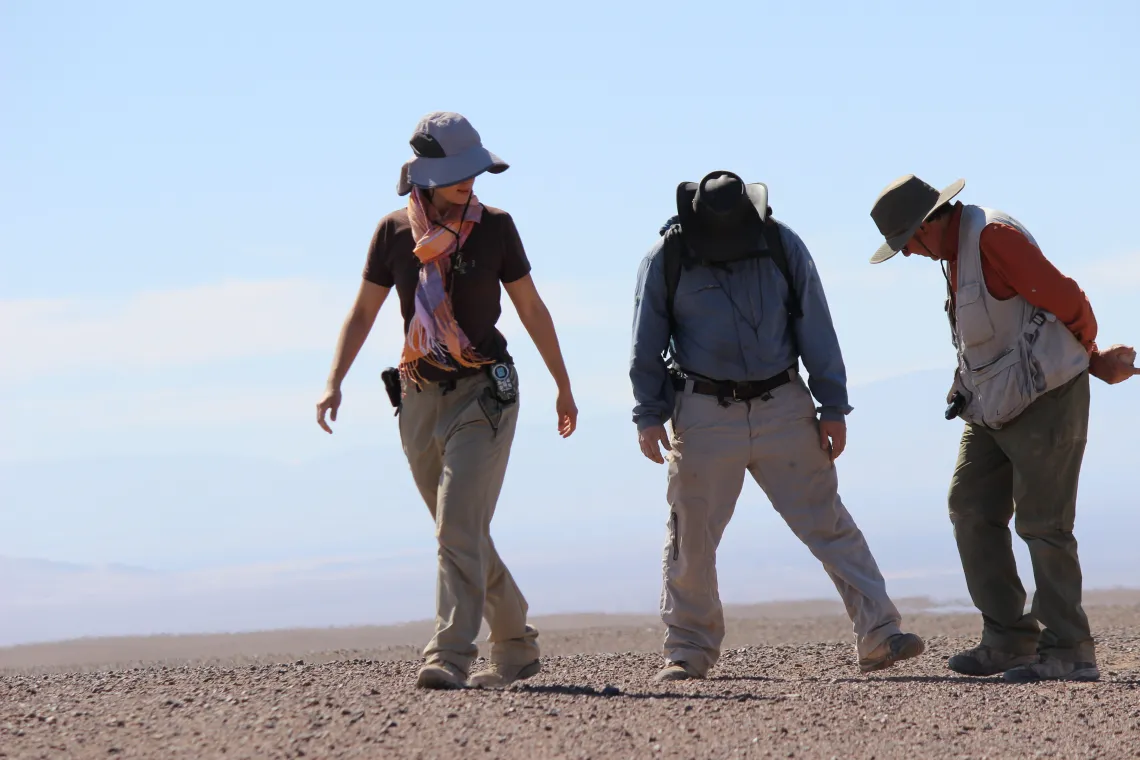Bringing the Distant Past to the Immediate Present

Paula Ugalde (left) completing survey work on site QM32, Pampa del Tamarugal, Chile, with the PIs of the research projects in Chile, Dr. Claudio Latorre (Pontificia Universidad Católica de Chile), and Dr. Calogero Santoro (Universidad de Tarapacá).
Photo credit: Paola Salgado.
By Elizabeth Labiner
Paula Ugalde grew up in northern Chile, in an archaeologically rich region near the borders of Peru and Bolivia. While at the Universidad de Chile in Santiago, Ugalde found herself studying archaeology in part because the field was an avenue through which she combined her passion for history and her love of the outdoors. As an archaeologist, she soon discovered the importance of anthropology and philosophy in her work. She felt this was perfect for her, however, because she has always had wide and varied interests. “I always felt drawn to many different areas of study,” she says, “and it sometimes even made me envy the people who had just one clear focus. But with archaeology, I’m able to encompass so many elements in one pursuit.”
After earning her undergraduate degree, Ugalde worked as a research assistant in Arica, Chile, for seven years. “That research group was like a family,” Ugalde reflects, “and we all had different disciplines. Archaeology is really about studying humans, and when you study humanity you can study art or science or politics; you can study all this and more through archaeology.” In addition, she also learned during this time to study landscapes, ecology, and climate as part of her archaeological work.
Ugalde was drawn to the doctoral program in anthropology at UA largely because of its interdisciplinarity, particularly in conjunction with the geosciences program. “I’ve always liked interdisciplinary approaches, because I think that reality is so layered and complex that studying reality from only one perspective is very biased,” she explains. “My work is like a hinge, connecting anthropology and geosciences through archaeology.”
Ugalde focuses on the early movements and settlements of humans in Chile through these various lenses, attempting to reconstruct human society, thoughts, and processes through what people left behind, as well as enhancing these findings through studying the rocks and sediments in which artifacts are found. The Atacama Desert was essentially an empty landscape at the time of the arrival of the first humans, Ugalde says, and they had to work to turn this harsh environment into home and to fill the landscape with names and meanings.
There are six main archaeological sites on which Ugalde and her colleagues work in the Atacama Desert; the sites came as something of a surprise, as they contradicted the assumption that the desert was too dry to have supported life. Their exciting findings are the subject of a documentary, Agua y Arena: Una Travesía por el Desierto de Atacama. Watch the trailer, which features Ugalde: https://www.youtube.com/watch?v=gM84J8oj0jg&feature=share
Ugalde hopes that her work in the past will positively impact the present:
I have big dreams that archaeology will teach people today that people of the past were very similar to us in many aspects, that they had different ways of thinking and seeing the world but that those views were as valid as ours. Through that, I’d like to teach about tolerance and respect for other societies and peoples today. There is a problem of “otherizing” people, of categorizing people as immoral or inferior because they’re different from us, because they have different practices, religions, or cosmologies, or even just look different. This is a problem that brings about violence and hatred, even within a shared society. I hope that if I can show that humans have always had a history of migration and mixing of populations, we can forge a stronger shared human narrative today.

